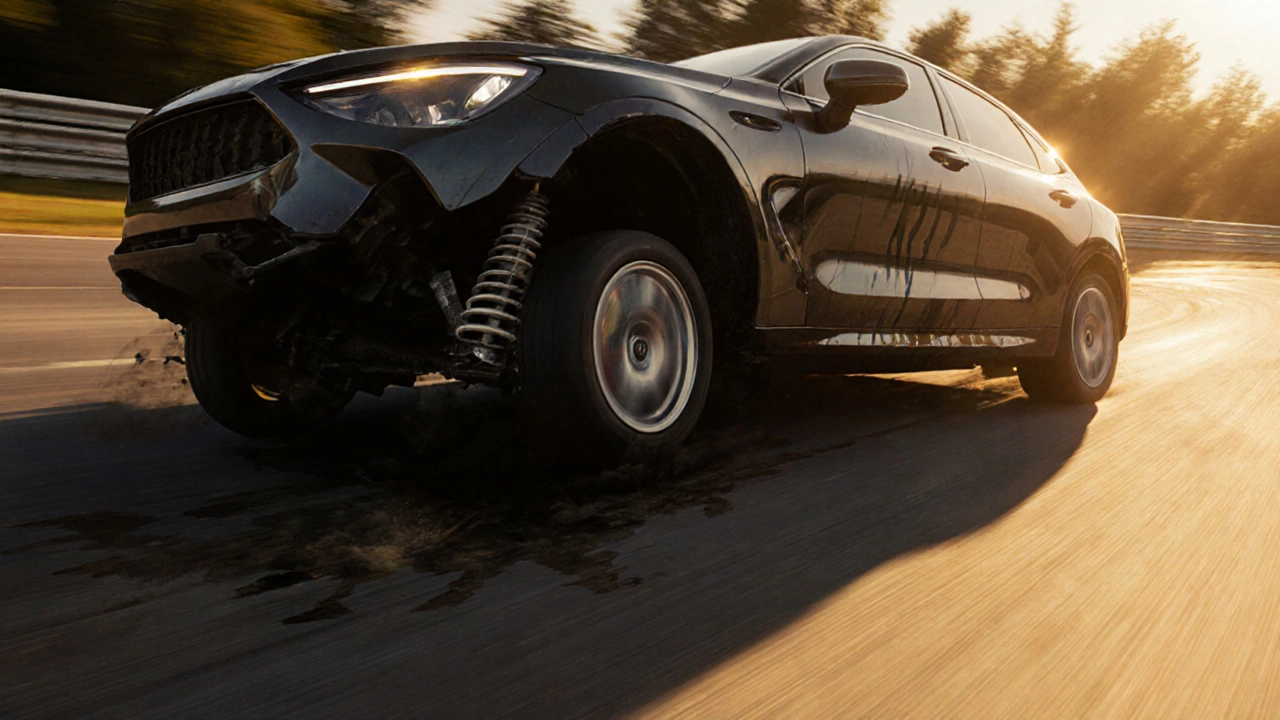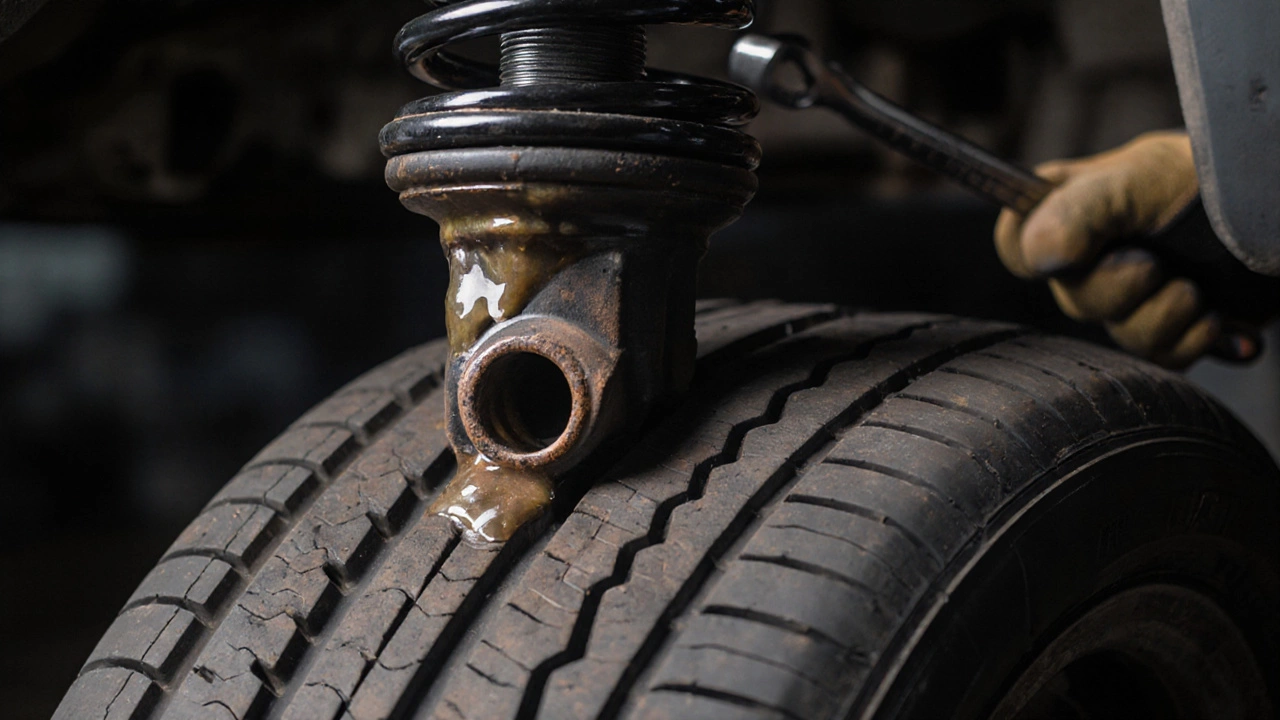Strut Symptom Checker
Check Your Symptoms
Select symptoms you're experiencing. This tool will help determine how likely your struts are failing.
One or two bounces is normal. Three or more is a sign of worn struts.
Feeling unstable or loose during cornering.
Car feels like it's floating before stopping or needing to brake earlier.
Metal-on-metal sounds from struts when hitting speed bumps or rough roads.
Scalloped dips around tire tread or uneven wear on edges.
Oil or dark residue dripping from strut housing.
Steering feels vague, wobbly, or doesn't return to center.
Vehicle appears tilted or uneven when parked.
Your Strut Assessment
Symptoms Selected
Recommendations
If your car feels like it’s bouncing off the road instead of gliding over it, or if you notice your vehicle dipping forward when you brake, you might be dealing with bad struts. Struts are a critical part of your car’s suspension system, combining the shock absorber and spring into one unit. They don’t just make your ride smoother-they help your tires stay in contact with the road, which affects braking, steering, and overall safety. When they go bad, the problems don’t stay hidden. You’ll feel them, hear them, and sometimes even see them.
Your car bounces too much after hitting a bump
A healthy strut absorbs energy from road irregularities and stops the spring from oscillating. If your struts are worn out, that energy has nowhere to go. After driving over a speed bump or pothole, your car will keep bouncing-up and down-like a pogo stick. One or two bounces are normal. Three or more? That’s a red flag. Try the bounce test: push down firmly on one corner of your car and let go. If it rebounds more than once or twice, your struts are likely worn out. This isn’t just an annoyance-it means your tires aren’t staying planted on the road, especially during emergency maneuvers.You feel excessive body roll when turning
When you take a corner at moderate speed, your car should lean slightly but stay stable. If it leans heavily, feels loose, or even sways side to side, your struts aren’t controlling the motion anymore. This is especially noticeable when merging onto highways or taking curves on winding roads. Worn struts reduce your ability to steer precisely and make the car feel disconnected from the road. Drivers often mistake this for poor tire grip or alignment issues, but it’s often the struts failing to hold the chassis steady.Braking distance has increased
Bad struts don’t just make your ride uncomfortable-they make it dangerous. When you hit the brakes, the weight of the car shifts forward. Good struts keep that shift under control, helping your tires maintain even contact with the pavement. Worn struts let the front end dive sharply, lifting the rear tires and reducing their grip. This can add up to 20% more stopping distance in emergency stops, according to tests by the National Highway Traffic Safety Administration. If you’ve noticed you’re braking earlier than before, or your car feels like it’s floating before it stops, struts could be the culprit.You hear clunking or knocking noises
A worn strut doesn’t just fail silently. You’ll often hear it. Clunking or knocking sounds when driving over bumps, speed bumps, or rough pavement are classic signs. The noise comes from metal parts inside the strut-like the mount, bearing, or piston-slamming together because the shock absorber fluid has leaked or the internal components are worn. Sometimes, you’ll hear a hollow thud when going over railroad tracks. If you hear this, don’t ignore it. These noises aren’t just annoying-they mean parts are breaking down inside the strut assembly.
Your tires are wearing unevenly
Tire wear is one of the clearest indicators of suspension problems. Bad struts cause the tire to bounce instead of staying flat on the road. This leads to cupping-a pattern of scalloped dips around the tire’s tread. It looks like little scoops have been carved out. Cupping usually shows up on one or two tires first. If you’ve replaced your tires recently and they’re wearing out fast, or you feel a vibration through the steering wheel, check the tread pattern. Cupping is almost always caused by failing struts or shocks. You might also notice uneven wear on the inside or outside edges of the tire, which can also point to alignment issues caused by worn suspension components.Fluid leaks around the struts
Struts are filled with hydraulic fluid that helps dampen movement. If you see oil or dark residue dripping or seeping from the strut housing-especially near the top or bottom-you have a leak. Even a small amount of fluid means the internal seal has failed. Once fluid leaks out, the strut can’t function properly. It won’t absorb shocks, and it’ll wear out faster. A visual inspection under the car, especially after a rainy day, can reveal this. Don’t wait for the leak to get worse. A leaking strut is a failing strut.Your steering feels loose or unstable
If your steering wheel feels vague, wobbly, or doesn’t return to center smoothly after a turn, it’s not just a wheel alignment issue. Struts connect directly to the steering knuckle. When the strut’s top mount or bearing wears out, it introduces play into the steering system. You might feel the car drifting slightly left or right, even on a straight road. This isn’t just inconvenient-it’s a safety risk, especially at highway speeds. Drivers often blame the power steering pump or rack, but worn struts are a more common cause of this type of instability.
Your car sits lower on one side
Struts support the weight of your vehicle. When one fails, especially the spring inside it, the car will sag on that side. If you notice your car looks tilted-like one corner is lower than the others-it’s likely a broken spring inside the strut. This isn’t always obvious unless you compare it to a similar car or measure the ride height. But if you’ve recently replaced tires and now the car looks uneven, or your headlights are pointing at the wrong angle, that’s a clue. A lowered corner means the strut isn’t holding up the weight it should, which throws off alignment and causes uneven tire wear.It’s time to replace them-here’s what to expect
Most struts last between 50,000 and 100,000 miles, but that depends on your driving habits and road conditions. If you drive mostly on rough roads, carry heavy loads, or frequently drive over potholes, they’ll wear out faster. Replacing struts isn’t a simple DIY job for most people. It requires compressing the spring, which can be dangerous without the right tools. Most mechanics recommend replacing struts in pairs-front or rear-to keep the suspension balanced. You’ll also want to get a wheel alignment afterward. Expect to pay between $450 and $900 for a pair, depending on your car model and whether you choose OEM or aftermarket parts.What happens if you ignore bad struts?
Ignoring worn struts doesn’t just make your ride rougher-it creates a chain reaction of damage. Your tires wear out faster, your brake pads overheat from increased stopping distance, and your steering and suspension components take extra stress. Over time, this can lead to expensive repairs: bent control arms, damaged ball joints, or even wheel hub failures. More importantly, your safety is at risk. In wet or icy conditions, bad struts can cause hydroplaning or loss of control during sudden turns. The National Transportation Safety Board has linked degraded suspension systems to multiple single-vehicle crashes where drivers lost control on otherwise dry roads.How do I know if my struts are bad or just my tires?
Tires can cause vibrations or noise, but they won’t make your car bounce multiple times after a bump or cause uneven cupping on the tread. If you see scalloped wear patterns on your tires, combined with a bouncy ride or clunking noises, it’s almost certainly the struts. A simple test: drive slowly over a bumpy road and listen. If the noise comes from the wheel wells and not the tires, it’s suspension.
Can I drive with bad struts?
You can, but you shouldn’t. Driving with worn struts reduces control, increases stopping distance, and accelerates wear on other parts of your car. It’s especially risky in rain, snow, or during emergency maneuvers. If you must drive, avoid highways, heavy traffic, and rough roads. Get them replaced as soon as possible.
Do I need to replace all four struts at once?
You don’t have to, but it’s strongly recommended. Struts wear evenly over time. Replacing only one can create an imbalance in handling, making the car pull to one side or feel unstable during braking and cornering. Replacing them in pairs (front or rear) ensures consistent performance and safety.
How long do struts usually last?
Most struts last between 50,000 and 100,000 miles. But if you drive on unpaved roads, haul heavy loads, or live in an area with lots of potholes, they may wear out closer to 40,000 miles. Check them every 50,000 miles or if you notice any symptoms like bouncing, noise, or uneven tire wear.
Are struts the same as shocks?
No. Struts are a structural part of the suspension and support the weight of the vehicle. Shocks are only dampers-they don’t support weight. Many modern cars use struts in the front and shocks in the rear. You can’t swap them. If your car has struts, you must replace them with struts.

